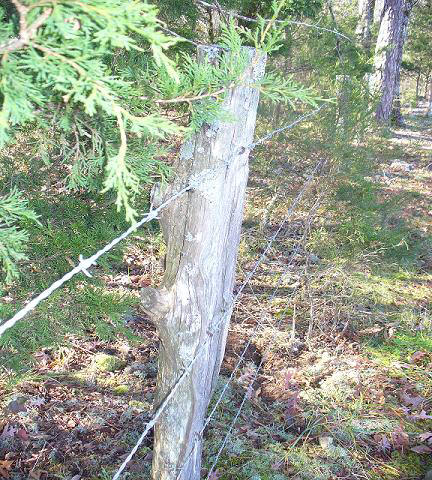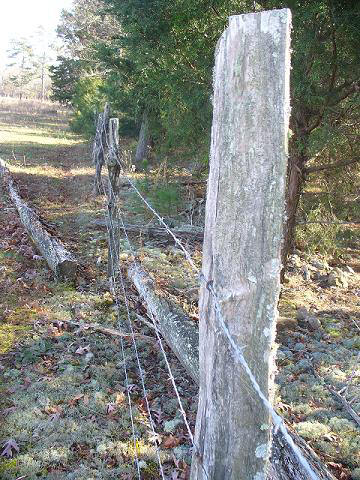The Diversity and Endurance of Arkansas Fence Posts: Homespun Advice From a
Veteran County Agent - Robert Seay, U of A Division of Agriculture.
First posted on 08-22-2008. Reprinted in the Montgomery County News.
BENTONVILLE, Ark. – I would wager that, in regards to fences or fence posts, your historical reference point is tied to Abe Lincoln. His oft-told story, after all, has since required that every successful politician make attempts to endear themselves to voters by developing similar grassroots connections.
The history of fencing is an interesting story of people learning to make do with natural materials. In Ol’ Abe’s case, trees and strong backs were plentiful so the rail fence was the norm. Stone was also a naturally occurring material in many areas and, like the trees; it had to be removed from many fields anyway. Aesthetically speaking, moss-covered stone and the gray patina of wood creates a favorable and lasting impression.
Picket fences, initially a patchwork of woven branches, were perhaps the first type of fence used centuries ago by shepherds. They were later improved as sawmills began to churn out lumber. Picket fences are still popular in urban areas, although vinyl materials are replacing wood.
Trees that proved their endurance to weather, rot, insects and livestock gained popularity with farmers since building fences has always been expensive in more ways than one. Fence posts of cedar, locust, white oak and Osage orange (or bois d’arc) have provided the standard of comparison for centuries. Some families can proudly point to a corner post with claims of it having been set by a great-grandfather. Obviously, the post was the more durable of the two.
The conquering of the Wild West by barbed wire has been recounted in numerous western movies. Since being introduced in the last half of the 20th century, many farmers would elevate the metal T-post to that same level of importance. Until recently the speed, durability and economics of building fence with T-post established an unsurpassed trend. However, the cost of metal in any form has caused the T-post market to escalate.
One side-effect is the sound of chain saws echoing across the Ozarks as they are once again used to cut wood posts. Unfortunately, a search for one of those durable individuals who could easily answer questions about the selection and use of native hardwoods for this purpose may take awhile.


"The unusual shape and gray patina of an old white oak fence post provides
a pleasant moment during a drive through rural Arkansas."
Trends - different states and different counties do things differently
especially fencing.
Bardless wire along the top strand so animals like deer do not cut themselves
when jumping.
Elsewhere using No.8 ga. wire for four strands and only barb wire along the top.
Dairy cattlemen often electrify a middle wire, some farms are entirely
electrified. My brother's place is.
Installing a barb wire about six inches out from the bottom on either side stops
animals from digging.
NW AR News
Horses, mules still reign for a few state growers by Nancy Cole.
Monday, May 4, 2009
MENA -
Buddy
Harbour gardens the old-fashioned way, with a horse and plow.
Buddy Harbour, 78, plows his garden with Copper, a Haflinger horse, at his home
in Mena. He's one of the few Arkansans who still put draft animals to work.
"It's the only way to make a garden," he said as his 12-yearold horse, Copper,
pulled a plow through a small backyard plot near Mena. "My daddy never owned a
tractor," said Harbour, 78, who grew up near Norman in Montgomery County.
Instead, the family relied on three or four horses or mules to cultivate and log
their land, he said. Although Harbour left the family farm to work in
construction, he spent several years training draft horses from Colorado to
Massachusetts. Many of those Belgians, Clydesdales, Percherons, Shires and
Suffolks weighed as much as 2,000 pounds and stood as high as 6 feet at the
shoulder, he said.
Copper, a Haflinger, weighs only 1,200 pounds and stands about 4 feet, 8 inches
high. Smaller and more versatile than traditional draft-horse breeds, Haflingers
can be used for pulling or riding. Harbour is one of only a handful of Arkansans
who still rely on animal power for farming or logging, said Steve Jones, equine
specialist with the University of Arkansas Cooperative Extension Service. ...